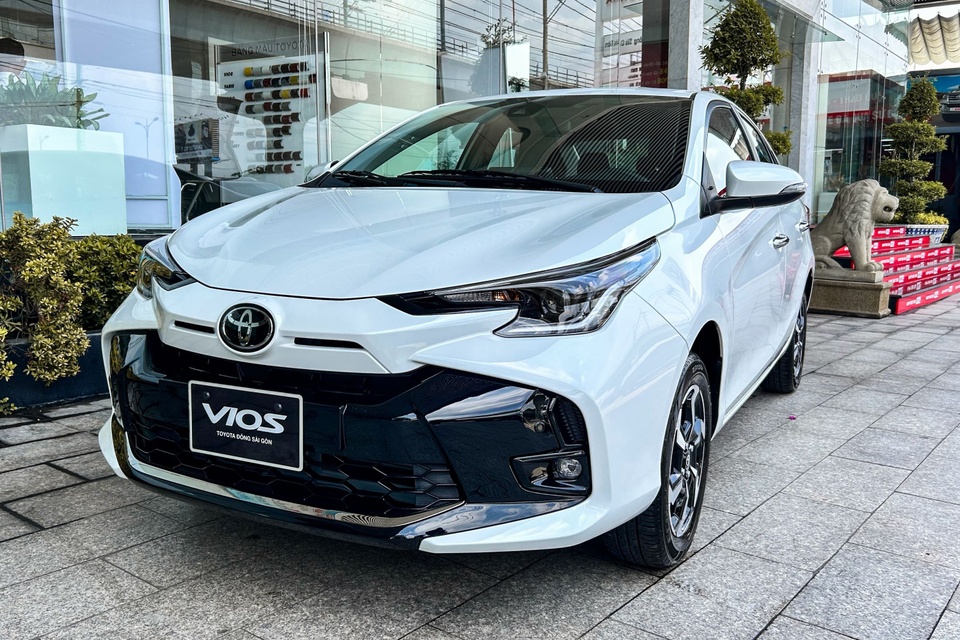
|
|
Toyota Vios sales declined by 74% in February. Photo: Minh Quân. |
According to the Vietnam Automobile Manufacturers Association (VAMA), total car sales in Vietnam in February continued to decline by 40% compared to the beginning of the year, reaching 11,633 vehicles. Of this number, the passenger car segment in the Vietnamese market accounted for 8,099 vehicles, equivalent to a 45% decrease compared to the previous reporting period.
Loss of nearly half of sales
In February, total sales in the B-class sedan segment reached 1,511 vehicles. Compared to the reporting period in January, the overall sales volume of the 7 models in this segment decreased by 1,106 vehicles, equivalent to a 42.3% drop in sales.
Of these, Suzuki Ciaz recorded no sales in the first month of 2024 in the Vietnamese market. Hyundai Accent’s sales dropped by more than 60%, with a total of 365 vehicles successfully delivered to customers in February.
| Honda City best-seller of the month, while Toyota Vios and Hyundai Accent both saw sales decline | |||
| Sales of B-class sedans in the last 2 months (Data: VAMA, TC Motor) | |||
| Brand | January | February | |
| Honda City | 482 | 640 | |
| Hyundai Accent | 916 | 365 | |
| Mazda2 | 372 | 250 | |
| Toyota Vios | 653 | 170 | |
| Mitsubishi Attrage | 150 | 67 | |
| Kia Soluto | 41 | 19 | |
| Suzuki Ciaz | 3 | 0 |
As for Toyota Vios, February saw the “former king” of sales experience a 74% decline compared to the beginning of the year. The Toyota’s B-sedan recorded sales of 170 vehicles, placing it behind Mazda2 in terms of sales volume in the reporting period in the first quarter.
With 250 units sold in the Vietnamese market, Mazda2 had a rare opportunity to enter the group of 3 most popular B-sedans despite a nearly 33% drop in sales. Mitsubishi Attrage also saw a decline of more than 55% in sales in February, reaching a volume of 67 units, while Kia confirmed the successful delivery of 19 cars to Vietnamese customers in the same period.
Honda City’s bright spot
Amidst the gloomy situation of the B-sedan segment in particular and the entire market in general, Honda City emerged as a rare bright spot, being one of the few models that saw a sales increase in February.
Honda’s B-sedan recorded sales of 640 vehicles, an increase of almost 33% compared to the 482 units sold in the first month of the year. This achievement not only helped Honda City lead the segment but also placed the B-sedan among the top 3 best-selling vehicles in the entire market, alongside Ford Ranger and Mitsubishi Xpander.
| |
|
Honda City best-selling model in the segment in February. Photo: Bối Hạ. |
However, despite the relatively positive sales results in February, Honda City has yet to surpass Hyundai Accent in cumulative sales. The Korean brand’s sedan achieved sales of 1,280 units after the first 2 months of the year, while Honda City’s figure is 1,122 units.
Toyota Vios (822 units after 2 months) temporarily ranks third in the segment in terms of cumulative sales, while Mazda2, with 622 units since the beginning of the year, has also surpassed Mitsubishi Attrage to close in on the top group.
Too early to be optimistic
Despite the rare bright spots, the B-sedan segment in particular and the Vietnamese car market in general are forecasted to continue facing many challenges in the remainder of 2024.
At present, car manufacturers are striving to promote promotions and incentives to reduce the financial burden on customers, thereby stimulating market demand and boosting sales.
Currently, the Honda City L and G versions manufactured in 2023 are receiving a 100% reduction in registration fees, along with an additional 30 million VND in cash. For the Honda City RS version, the registration fee support is 50%, plus one year of hull insurance and other gifts from dealerships.
Hyundai Accent is currently being offered incentives of 23-36 million VND by dealerships, depending on the version. The Hyundai’s B-sedan is being assembled domestically in a total of 4 versions, with retail prices ranging from 426 million to 542 million VND.
From March, all versions of Toyota Vios have also had their retail prices adjusted in a way that benefits Vietnamese customers. The highest reduction of 47 million VND is applied to the 1.5G CVT version, bringing the car price down to 545 million VND. The 1.5E CVT and 1.5E MT versions have a reduction of 21-40 million VND, bringing the current retail price to around 458-488 million VND.
Meanwhile, Mazda2, along with many other models of the same brand, has just had a wide-ranging price adjustment at the beginning of the year.
In this adjustment, all versions of the Mazda2 sedan have increased their retail prices by 10 million VND to 420-524 million VND. However, at the moment, the 1.5L Luxury version has just been discounted by the Japanese automaker by 5 million VND, now priced at 499 million VND.
| |
|
Mazda2 ranks third in the segment despite a slight price increase since the beginning of the year. Photo: Bối Hạ. |
The versions of the Mazda2 Sport, after 2 price adjustments, have increased by 38-43 million VND from the previous price range of 479-519 million VND. Currently, the Mazda2 Sport has retail prices in the Vietnamese market ranging from 517 million to 562 million VND.
Good books to read in the car
The Cars section brings readers good books with many fascinating topics. On journeys with cars, it is not uncommon for us to have moments of rest and relaxation, and books are a fascinating companion.
[QUICK REVIEW] Toyota Yaris Cross is coming to Vietnam: Putting pressure on Kia Seltos, Hyundai Creta
Positioned right below its “big brother” the Corolla Cross, the Toyota Yaris Cross boasts a fresh design and a range of modern features that are sure to shake up the crowded B-segment SUV market. Competing against formidable contenders such as the Kia Seltos, Hyundai Creta, Honda HR-V, and Mazda CX-30, the Yaris Cross stands out with its sleek design and advanced technology. Get ready to turn heads on the road with this impressive crossover.

























![[CAR REVIEW] Honda City 2023: Easily Satisfying Consumers](https://vnauto.net/wp-content/uploads/2023/10/xehay-hondacity-26092023-1-150x150.jpg)

![[QUICK REVIEW] Toyota Yaris Cross is coming to Vietnam: Putting pressure on Kia Seltos, Hyundai Creta](https://vnauto.net/wp-content/uploads/2023/10/xehay-toyotayariscross-14062023-4-150x150.jpg)
![[CAR REVIEW] Toyota Yaris 2019 after 3 years of use: Similar to Vios but “it’s quite different”](https://vnauto.net/wp-content/uploads/2023/10/xehay-toyotayaris2nd-24082022-12-150x150.jpg)











